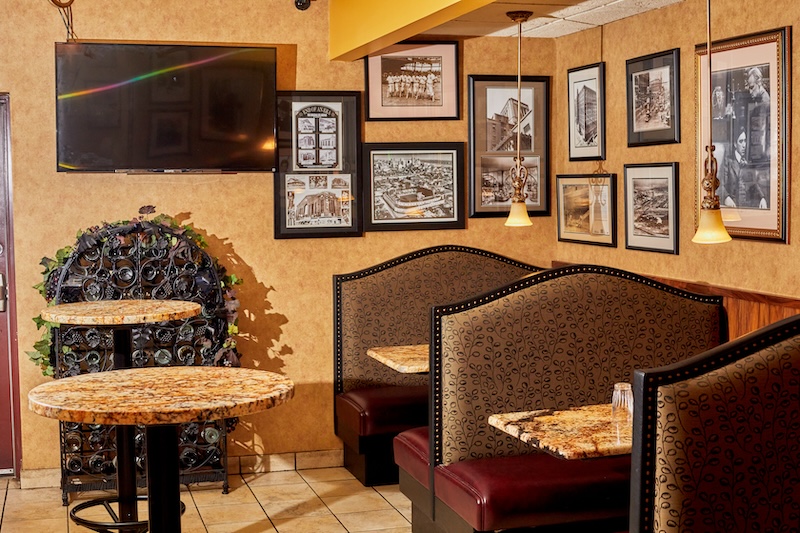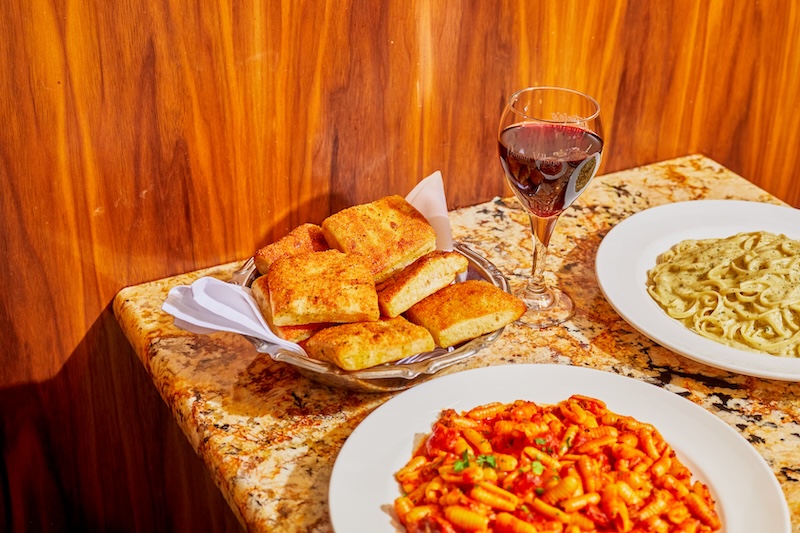
How does one face the daunting task of owning and operating five different restaurants? Well, it helps to have a big family.
The Rugieros have their collective hands full ÔÇö has been a mainstay in Dearborn for 60 years, and with four other restaurants in tow (each named AntonioÔÇÖs), it takes every last member of the family to make it work. Even the grandkids.
ÔÇ£My mom has 14 grandchildren,ÔÇØ says Patrick Rugiero, whoÔÇÖs managing at Roman Village most days, ÔÇ£and 11 of them work in the company.ÔÇØ
The Rugiero brothers ÔÇö Patrick, Anthony, Mark, and Robert ÔÇö grew up folding pizza boxes and washing dishes at the restaurant after school.
ÔÇ£It wasnÔÇÖt always fun,ÔÇØ laughs Anthony Rugiero, the CEO and president of the restaurants. ÔÇ£The restaurant was our playground. Our day care.ÔÇØ

Though the grandkids work in between college classes, the series of southeast Michigan Italian-American restaurants is held together by the Rugiero brothers and their mother, Enrica, better known as Rita. Antonio Rugiero, RitaÔÇÖs husband, purchased Roman Village when it was JoeÔÇÖs Pizzeria in 1964. He has since passed.
ÔÇ£WeÔÇÖre all a part of the same family,ÔÇØ Anthony says of the restaurants. In addition to Roman Village, there are three AntonioÔÇÖs Cucina Italiana locations (in Canton, Farmington Hills, and Dearborn Heights), plus in Livonia. ÔÇ£IÔÇÖm very proud. I donÔÇÖt like to think of us as a franchise. I look at it as one restaurant with five extensions.ÔÇØ
In a speech at Roman VillageÔÇÖs 60th anniversary party in April, Robert, the youngest brother, said a dedicated network of family and friends and a great staff have allowed the Rugieros to experience such success. But success is also achieved through great food and affordable prices; both have continued to anchor the family business.
What makes Roman Village such a breath of fresh air is that it remains unchanged in an ever-evolving restaurant landscape. By and large, pasta has become a luxury item. Today, itÔÇÖs standard practice to charge $25 for cacio e pepe (a dish that literally translates to two ingredients: cheese and pepper). Prices for fresh pasta around Detroit vary from $25 to $35, but at Roman Village, they hover reliably at $20 or less.
ÔÇ£Prices are ridiculous,ÔÇØ Patrick admits about a trend thatÔÇÖs prevalent across the country. Oftentimes, what you pay for at a restaurant is a show ÔÇö pink leather couches, chandeliers, the fancy environment. As a result, restaurants often charge $10 more for homemade pasta.

At Roman Village, though, you get it all. The environment is lively, the pasta is homemade, and the price remains a throwback. An enormous plate of spaghetti carbonara costs $21. Cavatelli Bolognese runs for $20, and a classic Italian-American fettuccine Alfredo only sets customers back $21.
Keep in mind that this is still fresh pasta ÔÇö pasta thatÔÇÖs made daily at each of the Rugiero-owned and -operated restaurants. Dough is made with eggs and flour, then extruded through a large pasta machine imported from Italy.
Linguine and fettuccine run through the machineÔÇÖs brass die, while other shapes like rigatoni and mostaccioli have their own separate attachments. Long, wavy sheets of pasta dough are cranked through to make lasagna as well as provide the foundation for stuffed pastas like ravioli and baci.
Baci, literally meaning ÔÇ£kissesÔÇÖÔÇÖ in Italian, are a small, stuffed, purse-shaped pasta that hails from the Piedmont region, which borders France and Switzerland. Roman Village highlights many pasta dishes native to northern Italy, whose cuisine is known for its hearty, rich sauces.
Take Roman VillageÔÇÖs Bolognese, which features a mix of beef and pork, plenty of tomatoes, aromatics, and a pour of heavy cream. The Gnocchi Rita Sauce, a recipe that comes directly from the matriarch, Rita, includes pancetta, mushrooms, and smooth pillows of potato gnocchi.

The comforting menu has translated well to DetroitÔÇÖs temperate climate. Though Antonio himself was from Calabria and crafted the coveted pizza recipe, RitaÔÇÖs central Italian roots are responsible for the menuÔÇÖs wonderful spread of robust rag├╣s, stuffed pastas, and American-influenced continental classics.
For the Alfredo sauce, cream is added, unlike in the traditional Roman preparation (butter and Parmesan). A plate littered with small, prosciutto- and Grana Padano-stuffed baci is accompanied by heavy cream and peas, giving a nod to an Americanized carbonara (though a classic carbonara made with eggs and pancetta also sits on the menu).
Soothing chicken pastina soup is made with poultry broth and little bits of freshly diced pasta from the extruder. Sun-dried tomatoes, a forgotten linchpin of the ÔÇÖ90s, find their way into aglio e olio, and chicken masala, veal piccata, and linguine and clams all make special appearances.
This isnÔÇÖt just a red-sauce joint in Detroit; this is the red-sauce joint in Detroit.
The food at Roman Village is saucy, and the portions are hefty. ÔÇ£WeÔÇÖre a family restaurant,ÔÇØ Anthony says. ÔÇ£And you canÔÇÖt call yourself a family restaurant if you canÔÇÖt take the whole family out to eat.ÔÇØ Anthony says consistency across the board is important for the restaurants. This consistency has resulted in not just longevity but expansion. Roman Village has undergone many renovations since Antonio bought the small pizzeria on a handshake deal written on a place mat in the ÔÇÖ60s.

Antonio and Enrica, both Italian immigrants who settled in Dearborn in the ÔÇÖ60s, had very different upbringings. Antonio was from southern Italy, and Enrica came from Gubbio, a small town in the central part of the country, nestled in the province of Umbria.
When asked if northern and southern Italian rivalry was a hurdle in their relationship, Patrick shoots an indignant look. ÔÇ£Are you kidding me?ÔÇØ Patrick fires back. ÔÇ£My mom didnÔÇÖt want to tell her father where he was from.ÔÇØ
However, Antonio was quite close with his father-in-law, Anthony says. Of his parents, he says, ÔÇ£They had to put food on the table. They had a dream: come to America, open a business, and have a family. That was their dream, and they worked hard for it.ÔÇØ
Recently, Roman Village celebrated its 60th anniversary with a party at the restaurant. The event was attended by family, friends, and employees of the past. Busboys who have since become busmen were in attendance, and one of its oldest retired cooks and pasta-makers, Laverne, came to show respect. At Roman Village, even when you hit 80, that doesnÔÇÖt mean you stop cooking. ÔÇ£Stick around ÔÇö my mom will be here later,ÔÇØ Patrick says with a laugh during a busy lunch service.
With five successful restaurants, whatÔÇÖs next for the Rugiero family? Perhaps a sixth location eventually, Anthony hints. Additionally, a cookbook featuring Mama RitaÔÇÖs recipes is currently in the works. Keep in mind these are recipes that Patrick had to fight tooth and nail to extract. Getting treasured recipes from any Italian, even your own mother, proved to be a daunting task.

Meanwhile, the Rugiero family continues to give back to the community in generous ways, following in the footsteps of Antonio. The Rugiero Promise Foundation, founded by Anthony, raises funds for numerous health and goodwill initiatives, as well as for the arts (the family is passionate about Italian opera).
For the 31st year in a row this past June, all five restaurants hosted Feast of St. Antonio Day, providing a free lunch buffet to all who attended and accepting pay-what-you-can donations, with proceeds going to the and . Additionally, the foundation raised over $500,000 at an annual event last year to fund diabetes research ÔÇö a cause near and dear to the Rugieros: the condition took AntonioÔÇÖs life in 2008.
Patrick has helped raise millions of dollars for community organizations like the . CEF provides comprehensive health care for children with developmental disabilities throughout southeast Michigan. It also offers valuable support for caregivers, helping them find the right schools and insurance and, in general, tackle whatever problems may arise. Patrick oversees the centerÔÇÖs Red Tie event, in addition to serving on a total of six boards in Detroit.
Mary Kosch, of (another historic family-run business), is the co-chair of the advisory council for CEF and works with Patrick directly to raise money for services not covered by insurance. ÔÇ£I call him a wonderful madman,ÔÇØ Mary says with a laugh. ÔÇ£HeÔÇÖs so connected, heÔÇÖs got a heart of gold, and he canÔÇÖt say no.ÔÇØ
Joe Vicari of Andiamo fame, proprietor of the , spoke about the Rugiero familyÔÇÖs lasting success. Vicari named consistency, quality product, and a loyal staff as the keys to Roman VillageÔÇÖs success. ÔÇ£Their staff is a testament to them. ItÔÇÖs leadership. ItÔÇÖs being treated fairly. They treat people fairly.ÔÇØ

Anthony also boasts about his management staff. Across the five restaurants, Roman Village employs 16 managers. Among those 16, the shortest tenure is five years. The oldest manager has been with the family for 32 years. In short, people love working for the Rugieros.
ÔÇ£The success of the family over the last 60 years has been a lot of dedicated work,ÔÇØ Vicari says.
ÔÇ£Now, theyÔÇÖre going to their third generation. The restaurants are going to be in good hands and will be around for another 60 years.ÔÇØ
Roman Village, a restaurant forged by familial strength and community, remains a pillar in Dearborn and an outlier in a constantly developing industry. Go to Roman Village for a show but also to support one of the cityÔÇÖs most influential families. The recipes at the restaurant are decades old, and each one represents a part of the familyÔÇÖs culture, ties, and history.
And the Rugieros are always eager to share their history with you, one bite at a time.
This story originally appeared in the July 2024 issue of ║┌┴¤═° Detroit magazine. To read more, pick up a copy of ║┌┴¤═° Detroit at a local retail outlet. Our digital edition will be available on July 8.
|
| ╠² |
|








